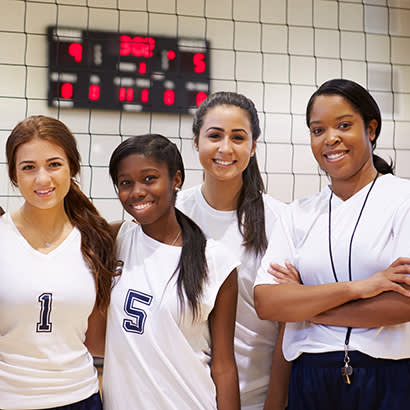
For an enhanced digital experience, read this story in the ezine.
February 2, 2022 marks National Girls and Women in Sports Day — an ideal kick-off point for the 50th anniversary of Title IX on June 23, 2022, the federal law prohibiting gender discrimination in publicly-funded school and college sports programs. Title IX has opened athletics doors to millions of girls and women over the past five decades. Similarly, park and recreation agencies can work on and celebrate engaging girls and women in sports and physical activity during these events and each day of the year.
Girls playing sports attain higher levels of education, are healthier mentally and physically, and even earn higher wages as adults, compared to non-athlete peers. Girls and women of color, in particular, experience big lifelong dividends from sports play, and yet too often have the least opportunity and equity in programming. Thus, focusing on engaging girls and women of color, especially in low-income areas, is key to ensuring everyone can get into and enjoy sports and physical activity for a lifetime.
Here are nine ways your agency can instill gender equity in youth athletics during this Title IX anniversary:
1. Ask girls what’s needed.
Ask girls, their leagues, their families and their coaches what they would like to see in youth athletics. Simple no-cost surveys and quick conversations with stakeholders can yield critical information, such as the sports girls want to play. Find out whether girls are getting to play what they like and getting equitable access to facilities and support. If not, adjust and equalize.
2. Prioritize time and resources for equity.
Ensure there is staff time and budget support to afford girls and their teams the facility space they need, coaches to anchor programs, and the publicity and promotion necessary to help spur equity. Sometimes, answers are simple, like more levels of an existing sport (for novices), a buddy registration system for girls wanting to know one teammate, or creative facilities sharing.
3. Recruit and retain supportive women coaches.
Girls having a woman role model in a coaching and/or staff position is enormously powerful for making girls’ experiences positive and in helping ensure girls return for future seasons. Men who coach all-girls teams and/or girls in coed contexts also can be intentional and proactive about providing equal and inclusive sports environments. Coaching Corps and a number of nonprofit organizations, such as the Women’s Sports Foundation, have a wide range of free online, on-demand tools for recruiting, retaining and training coaches.
4. Get the ball rolling!
Examine gender equity in youth sports offerings in terms of actual participants. Count how many girls compared to boys (and all kids of any gender identity) are playing across department and third-party programs, such as Little League softball and baseball or American Youth Soccer Organization — enabled by public resources that should be available to all. If girls make up 50 percent of the youth community, yet girls are only a small fraction of the youth sports participants, that is core information to spur steps to make programs more equitable. Girls usually want to play sports in far greater numbers if programming is offered in an inclusive manner.
5. Celebrate girls and women in sports.
Celebrate girls and women in sports by having events for February’s National Girls and Women in Sports Day, the June Title IX anniversary, and at other points throughout the year. For example, have a Women’s World Cup (2023), Women’s National Basketball Association — or WNBA — or women’s college team watch party. Feature local girl and women athletes in community newsletters and at events.
6. Coordinate among institutions.
Work with your local schools and districts to share space to ensure girls and their teams have the facilities they need to maintain and grow programs, and communicate regarding outreach (e.g., sharing fliers). Also, noting the popular sport offerings at local schools can help park and recreation departments determine their girls’ offerings, and vice versa.
7. Build a culture of equity in youth sports.
Assessing the existing youth sports culture to determine which kids and segments of the community are not present and connected is fundamental to making effective changes and sharing public resources. Make certain your user groups and staff are seeking to help all kids participate in youth athletics, regardless of gender identity, race, ability to pay and experience level.
8. Assess coed and add all-girls programs.
Assess whether “coed” is working for girls and what changes might be useful. In addition to segments of girls enjoying coed sports teams and leagues, in many areas, departments are finding that at all ages girls often prefer an all-girls sport environment that helps girls engage and stay on teams.
9. Follow best practices.
Reach out to the numerous departments nationwide successfully expanding and equalizing youth athletics programming for girls for tips on how to launch all-girls teams and leagues. Review and adjust historical permitting practices, so new user groups (e.g., girls’ leagues) can access facilities. Make sure girls and their teams and leagues are welcome and centered in offerings.
Editor's Note: This article has been edited from its original version.
Kim Turner is Gender Equity Initiative Director for Coaching Corps and is a lifelong athlete, youth coach and longtime nonprofit Title IX attorney.

